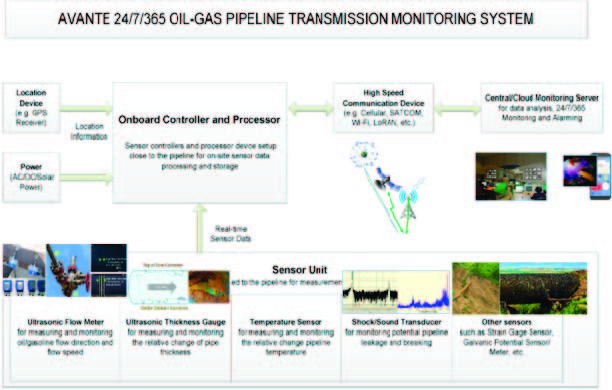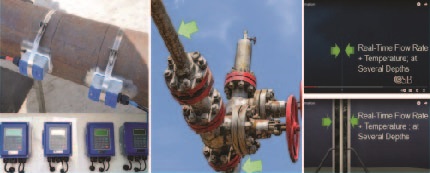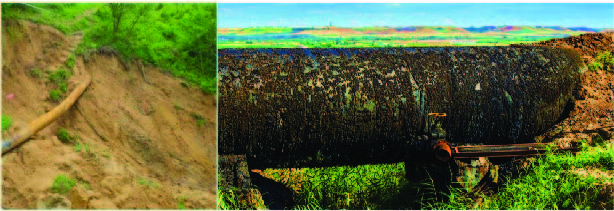Fluid flow measurement devices that are currently available offer accurate accounting of all contents being transmitted through the pipeline. However, they are typically installed on critical choke points, which means that they are not always useful in determining the exact locations of leaks along the entirety of the pipeline. Similarly, they may also not always be coupled with other suitable sensors to provide additional diagnostics for event confirmation.
To help solve this problem, Avante’s Pipeline Integrity Monitoring System incorporates multiple modules of sensors that are installed externally and non-intrusively for both quantitative and relative measurements of different variables that can affect a pipeline’s functionality. These factors can include:
- Changes in relative flow rate, flow paths, and the presence or absence of flow
- Leakage and operational errors, which are detected via vibration and temperature data analysis
- Avante’s PIMS also utilizes vibration analysis to distinguish excavation and geohazards from drilling and cutting for tampering and theft.
The data from each sensor module are collected in a separate controller and processor that are powered by AC, battery and preferably backed with recharging from solar when other power sources are not available.
The pre-assignment IP addresses of the monitoring units are logged with the data, which are also tagged with GPS locations and time stamps in the monitoring system. The data are then communicated via a high-speed network (cellular, satcom, Wi-Fi, LoRAN, wireless mesh network, etc.) to a central monitoring center server for 24/7/365 monitoring and real-time alerts.

Corrosion Induced Leakage Contributes to Most Oil and Gas Transmission Loss
The inevitable corrosion of pipelines used in oil and gas transmission, particularly internal corrosion, is one of the leading causes of the failures that can result in contamination of the environment. Corrosive factors are especially significant on the top side of a pipeline. Known as Top-of-line-Corrosion (TOLC), this process occurs as a result of different factors than Under Deposit Corrosion (UDC), which happens on the bottom side of the pipe. This is illustrated in the image below.

The bottom side of the pipeline tends to have the higher density components such as solids, water along water soluble acids to settle on the bottom and cause different types of corrosion, and thus called under deposit corrosion (UDC).
It is the slow thinning and the RATE OF THINNING caused by corrosion to provide the predictive capability for replacement of remedial actions in chemically modified the oil and gas characteristics before feeding into transmission.
Avante’s pipeline monitoring system is used for corrosion thinning of the transmission pipeline even without knowing the original wall thickness. Typical accuracy or resolution depends on the overall thickness and are in most cases better than 0.01mm.
In addition to the top-bottom-side positions, additional sensor probes can also be placed along the pipelines for more capability in catching the coating degradation points whereby provide more predictability. Avante’s pipeline thickness measurement module is designed to have capability of multiple channels for up to 8 or more probes with switching mechanism to provide that capability.
Flow of Oil and Gas Along and at Choke Points of the Pipelines are Non-Intrusively Monitored for Safety and Security
Fluid flow measuring devices are available for accurate accounting for all contents being transmitted by the pipeline. However, they are installed mainly in critical choke points and are not always useful in determining exact locations of leaks along the miles or kilometers of the transmission pipelines. They are also not coupled with other suitable sensors to provide additional diagnostics for event confirmation.
- AVANTE Pipeline Integrity Monitoring System incorporates multiple modules of sensors that are installed externally and non-intrusively for quantitative and/or relative measurements of factors along the pipelines that affects functioning.
- Changes in relative differential flow rate; flow paths, present-absent of flow; coupling with vibration and temperature data are used in leakage and operational errors analysis to provide actionable alerts and remedial actions.
- Vibration analysis is used in AVANTE PIMS in distinguishing excavation and geohazards from drilling and cutting for tampering and theft.
- Coupling of all of the different sensor modules in detecting all of the factors that affects the oil and gas transmission, and data cumulative over time, AVANTE PIMS can provide a much more artificial intelligence-based analysis for preventative and timely maintenance and disaster prevention.

Vibration Modes, Spectrum Analysis in Time and Frequency Domains of the Oil and Gas Pipeline Transmission Provides Actionable Intelligence for Excavation and Theft
Vibration analysis is used in AVANTE PIMS in distinguishing excavation and geohazards from drilling and cutting for tampering and theft.
- Excavation, digging, earthquakes, and other geohazards induced pipeline vibration tends to be low in 10-100 Hz ranges. The duration of each vibration also tends to be slow and intermittent. Their intensity will be higher when they happened closer to the pipeline. Timely alerts and remedial actions taken for accident prevention.
- Drilling, cutting and direct mechanical actions (including gears induced wear vibration) on the metal pipeline tends to be higher in frequency domains and their actions tends to be continuous for a reasonable time domain. This type of vibration wave tends to travel far and thus easily intercepted with AVANTE PIMS installed in kilometer or less distance between sensor modules and at choke points for timely actionable alerts. Theft and equipment failure induced loss can be minimized.
- The data from all sensor modules are gathered in suitable period and duration, they are collected in a separate controller and processor that are powered by AC, battery and preferably backed with recharging from solar when other power sources are not available.
- The locations besides pre-assignment IP addresses of the monitoring unit and are logged with the data that are also tagged with GPS location and date-time incorporated in the monitoring system.
- The data are communicated in high speed with one of cellular, satcom, Wi-Fi, LoRAN, wireless mesh network, etc. to central monitoring center server for 24/7/365 monitoring and in case of exceptions, to provide real-time alerts.

Strain Monitoring for Gradual and Sudden Geohazards Induced Oil and Gas Pipeline Transmission Damages
The geohazards such as soil erosion, land slide, earthquakes and other related geohazards can move, bend, deform the pipeline to cause immediate or subsequent rupture and leaks.
- Strain gages with multiple directions are can be mounted onto the surface of the transmission pipeline with high strength adhesive with adequate flexibility as not to crack with bending. The strain data along one or more directions are measured periodically depending the geohazard potential.
- The magnitude of bending and their relative rate of change are important factors in providing alerts. The excessive strain as prescribed can trigger an alert to the controlling organization including the suitable local and/or relevant government agencies for possible onsite inspection and/or remediation.
Temperature sensors help to provide supplementary data when the changes are sudden and/or extreme.

To reach Avante International Technology for more information on our Pipeline Integrity Monitoring System, or to ask about how this system can best fit your unique application, please take a moment to fill out our short Application Assistance Form.
